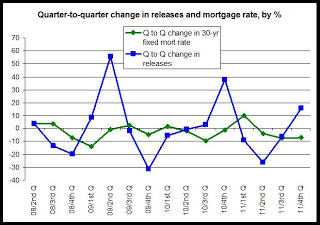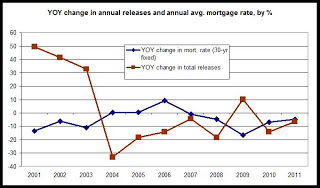The report notes that, in general, release activity responds to movements in the mortgage rate in ways very similar to that seen in mortgage refinance activity. For example, in the first chart, we see that there was a surge in release activity in 2003.

The first graph shows the quarter-to-quarter changes in the 30-yr fixed mortgage rate and in the number of releases. The quarterly data goes back to 2008. Release activity tends to move in the opposite direction of trends in the mortgage rate. In general, the blue line will move above zero following a period in which the green line is below zero. So, after growth in the mortgage rate turned negative during the 4th q of 2008, release activity moved above zero, topping out at a growth rate of more than 50 percent. In other words, a dip in the mortgage rate produced a surge in release activity. A similar phenomenon can then be seen again following the third quarter of 2010, and then again following the third quarter of 2011. Note, however, that the increase in release activity gets smaller after each period of declining mortgage rates. The effect of pushing down the mortgage rate appears to be diminishing when it comes to release activity.
The second graph shows the same measure, except on a year-to-year basis. Given the longer time period, in the annual data, there is not the lag we see in the quarterly data. A year that shows falling mortgage rates shows a rise in release activity, in most cases.
Note that 2001, 2002, and 2003 all showed drops in the mortgage rate, which was mirrored by significant increases in release activity. Mortgage rate growth then turned positive and release activity dropped. We then see mortgage rate growth turn negative again in 2008 and 2009 as the financial crisis became a factor. This produced a bump in release activity during 2009.
Note, however that in 2010 and 2011, the mortgage rate moved downward, but so did release activity, which is contrary to the usual trend, and suggests that further declines in the mortgage rate are not producing the usual surges in release activity.

See the full report here.